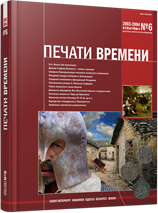Фунский замок Александра – крымского шурина Стефана Великого
Funa of Alexander, Stephan the Great’ s Crimean Brother-in-Law
Author(s): Vladimir P. KirilkoSubject(s): History, Architecture, Middle Ages, 15th Century
Published by: Издательский дом Stratum, Университет «Высшая антропологическая школа»
Summary/Abstract: The castle of Funa belonged to Alexander, a representative of the ruling dynasty in principality of Theodoro, who in 1472 became related with Stephan the Great, the Moldavian Prince (who married to Alexander’s sister Maria). The fortified ensemble of Funa had three explicitly marked construction periods. The fortification was erected between 1422 and late 1423, most likely in spring-summer of 1423, to be massively destroyed by a powerful earth-quake in October-November of 1423. It is presumed that in 1425 the fortification was restored, soon to be burnt down. Nothing is known about the exact causes and the date of the fire. In 1459, the fortress was subjected to a considerable reconstruction and turned into a castle. A dungeon became the dominant feature of the new fortification. It was a monumental three-storey building and was a powerful, well-equipped and quite good-looking defense construction. The castle ceased to exist in 1475. Most likely, Alexander came to the court of Stephan the Great in September 1472, while accompanying his sister to her wedding. He retuned to Crimea in June 1475, where not without his brother-in-law’s help, “he took over his patrimony”. As the last ruler of the Theodorite Gothia he then had to stand against selected Ottoman troops led by the Great Vizier Kedyk-Ahmed-Pasha who seized Mangoup. Although Alexander’s life in Moldavia is not elucidated by the known records, though his military skills and experience of building fortifications could hardly remain unused.
Journal: Stratum plus. Археология и культурная антропология
- Issue Year: 2004
- Issue No: 6
- Page Range: 131-179
- Page Count: 49
- Language: Russian
- Content File-PDF

